Closed Loop AIO Liquid Coolers: 14-way Mega Roundup Review
by E. Fylladitakis on February 12, 2014 7:00 AM ESTTesting Results, Maximum Fan Speed (12V)
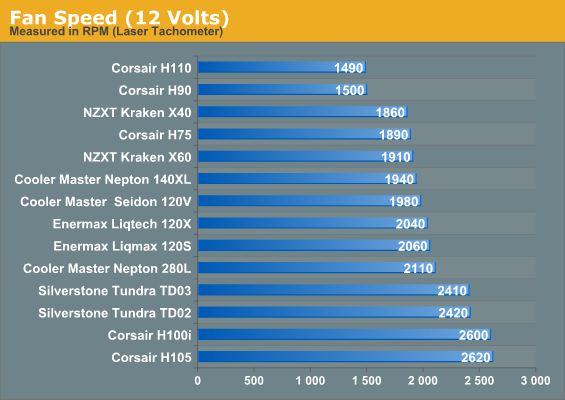
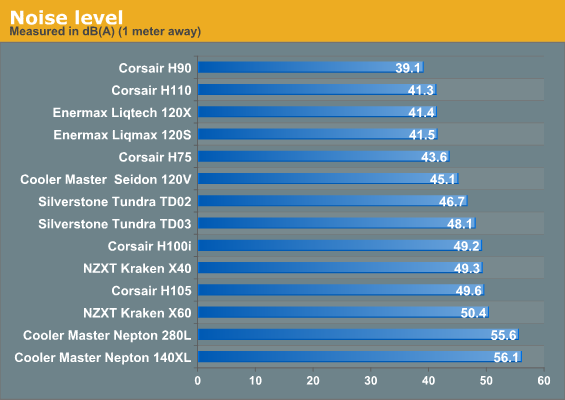
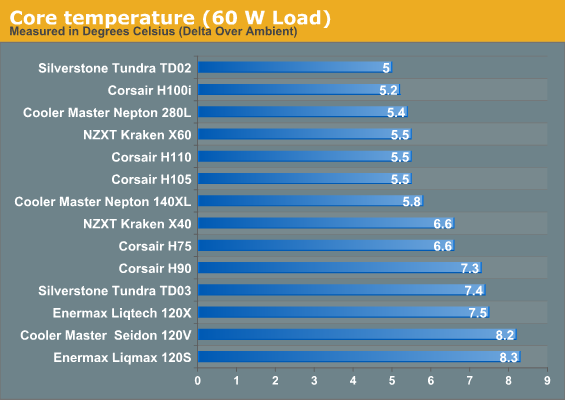
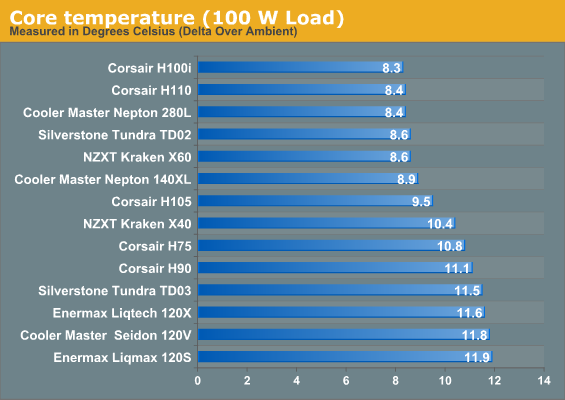
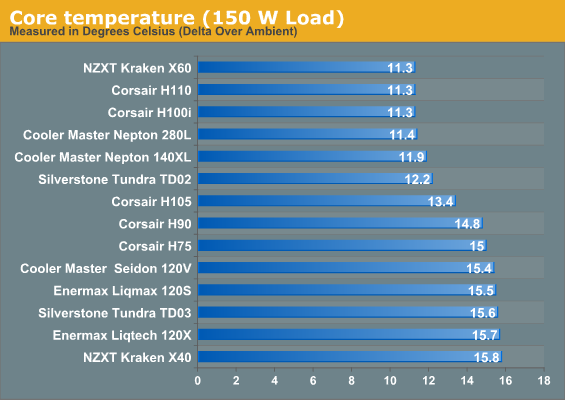
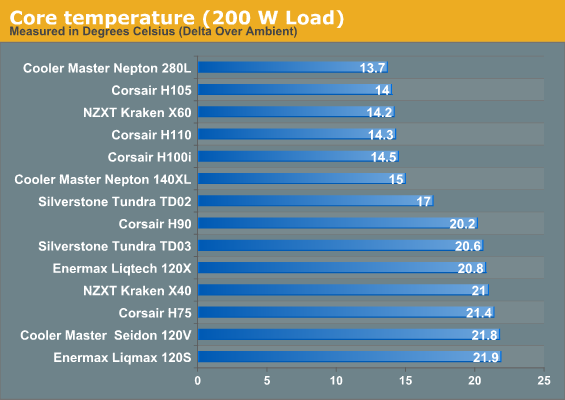

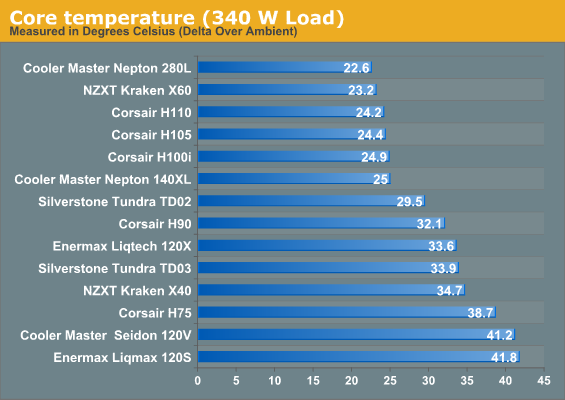

The above charts depict exactly why a user needs to be more than just a little careful when selecting a cooler. Even though they appear similar and some of them even nearly identical, the performance of each and every AIO cooler that we have tested varies greatly. For instance, Cooler Master obviously sought to provide the best heavy-load performance possible and they did manage to reach the top of our charts; however, the noise of the fans that Cooler Master supplied at maximum speed is intolerable for daily use by any standards.
To give you a rough estimate, 56 dB(A) represents about the same level of sound as a typical box fan the same distance. The Nepton 280L is closely followed by the NZXT Kraken X60 and then the Corsair H110, both of which share about the same size and design but not nearly the same noise levels. The NZXT Kraken X60 is over 5 dB(A) quieter than the Nepton 280L, a very perceptible difference, while the Corsair H110 generates only 41.3 dB(A), which is equivalent to a soft humming noise and fairly comfortable for daily use.
Naturally, the performance decreases as we move to AIO coolers with smaller radiators, with the Corsair H100i leading the coolers using 120mm fans but its stock fans run at 2600 RPM, generating high noise levels. The Enermax Liqtech 120X and Silverstone Tundra TD03 and their beefy radiators deliver great thermal performance when compared to other single-fan AIO coolers, although Enermax proved that they could offer roughly the same performance with just one fan and much lower noise levels, making Silverstone's choice to include two fans appear somewhat redundant.
Under a low thermal load however, the charts shift greatly. As the thermal load is much lower, the low temperature dissipation efficiency of the cooler now matters a lot more than its maximum thermal load capacity. Corsair's H100i offers the best thermal performance, outperforming coolers with significantly larger radiators, including Corsair's own H110, closely followed by another 240mm long cooler, the Silverstone Tundra TD02. The gap between the budget-level and high-performance products now closes, with the Corsair H75 being the most notable example, as it manages to outperform its own larger version, the H105. Apparently, bigger is not always better and the lower flow resistance of the single fan radiator gives the Corsair H75 a faster energy transfer rate at lower temperature deltas.










139 Comments
View All Comments
thewhat - Wednesday, February 12, 2014 - link
"the Corsair H90 ... is entirely silent when its fan's voltage is reduced down to 7 Volts."I've tried some of the quietest fans in existence and at 920 rpm they weren't even quiet, let alone entirely silent.
Anything over 600-700 rpm is usually audible, but quiet. And at around 800 rpm it stops being quiet.
Maybe we just have different standards for quietness.
But then liquid cooling was never a good option for silence freaks, anyway.
E.Fyll - Wednesday, February 12, 2014 - link
There are great differences between fans, even at same RPM, depending on their engine and wing design. This is also being displayed in this review, as fans running at nearly the same RPM have vast performance differences. At one meter away, I could not possibly discern any noise coming from the H90, that is why I classified it as silent. If however you were to install it inside a metallic case with many openings, which would reflect and enhance the noise level, you might be able to notice a low-tone humming noise - that's a maybe, a mere assumption on my part.Aikouka - Wednesday, February 12, 2014 - link
I don't know if anyone else considers it to be worthwhile, but I wouldn't mind seeing how well these coolers work when you remove one of the commonly-changed variables: the fans. I rarely ever use stock fans, and along those lines, it would be interesting to see what would happen if the same fans (per standard size -- 120mm and 140mm) were used on each cooler.jjj - Wednesday, February 12, 2014 - link
Pretty pointless without a comparison with the same fans and some air coolers.silenceisgolden - Wednesday, February 12, 2014 - link
I'm a little disappointed that patent trolls kept the Swiftech offerings from this list, but that's how things are I guess.casteve - Wednesday, February 12, 2014 - link
Thanks for the review. What was the ambient noise level and the noise meter used for the test?E.Fyll - Wednesday, February 12, 2014 - link
My apologies, I should have added this into the review. Will do so from now on. The meter is an Extech HD600 and the background noise level is 30.4 dB(A) (+/- about 0.5 dB(A), depending on the night I perform a test).casteve - Wednesday, February 12, 2014 - link
Thanks. As this meter has a lower limit of 30dB(A) and an accuracy of +/-1.4dB, your ambient is probably quieter and you are just seeing the low end of what the meter can do. Sort of expected unless (as you say) you have an expensive set up for the test equipment. Get Anand to shill out the $'s for a 10dBA microphone and an anechoic chamber for that spare bedroom. :)Some terms - if the meter is reading sound pressure level, then it's dB(A) SPL, which is referenced to 20 micro Pascals (0 dB). So, 0 dB(A) SPL is the threshold of hearing, 20-30dB(A) SPL is a calm room.
pcfxer - Wednesday, February 12, 2014 - link
All of these are way too loud. At 30+ dB, none of these coolers hit the envelope for someone who actually cares about "silence" and noise.E.Fyll - Wednesday, February 12, 2014 - link
You are confusing dB and dB(A), I am afraid. The background noise of my room at 2:00AM is 30.4 dB(A). Sub-35 dB(A) levels are generally impossible to notice by a human ear. Sub-30 dB(A) levels are next to impossible to record with anything less than science lab-grade equipment. There is no handheld or desktop dB(A) meter that can perform such readings. If you have seen reviews stating sub-30 dB(A) levels, make sure to check their methodology (given that there is any). Either the meter cannot read lower than 30 dB(A) (and/or will display a bogus reading, as most cheap Chinese meters do) and the review is a fictional text or their methodology is based on dB readings, not dB(A) readings, which is useless to a consumer.